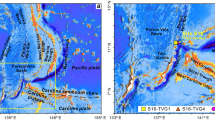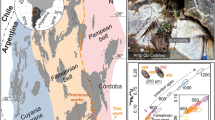Abstract
Mafic and ultramafic rocks sampled in the Garrett transform fault at 13°28′S on the East Pacific Rise (EPR) provide insight on magmatic processes occurring under a fast-spreading ridge system. Serpentinized harzburgite from Garrett have modal, mineral and bulk chemical compositions consistent with being mantle residue of a high degree of partial melting. Along with other EPR localities (Terevaka transform fault and Hess Deep), these harzburgites are among the most residual and depleted in magmatophile elements of the entire mid-ocean ridge system. Geothermometric calculations using olivine-spinel pairs indicate a mean temperature of 759 ± 25 °C for Garrett residual harzburgite similar to the average of 755 °C for tectonite peridotites from slow-spreading ridges. Results of this study show that mid-ocean ridge peridotites are subject to both fractional melting and metasomatic processes. Evidence for mantle metasomatism is ubiquitous in harzburgite and is likely widespread in the entire Garrett peridotite massif. Magma-harzburgite interactions are very well preserved as pyroxenite lenses, plagioclase dunite pockets or dunitic wall rock to intrusive gabbros. Abundant gabbroic rocks are found as intrusive pockets and dikes in harzburgite and have been injected in the following sequence: olivine-gabbro, gabbro, gabbronorite, and ferrogabbro. The wide variety of magmas that crystallized into gabbros contrast sharply with present-day intratransform basalts, which have a highly primitive composition. Ferrogabbro dikes have been intruded at the ridge-transform intersection and as they represent the last event of a succession of gabbros intrusive into the peridotite, they likely constrain the origin of the entire peridotite massif to the same location. In peridotite massifs from Pacific transform faults (Garrett and Terevaka), primitive to fractionated basaltic magmas have flowed and crystallized variable amounts of dunite (±plagioclase) and minor pyroxenite, followed by a succession of cumulate gabbroic dikes which have extensively intruded and modified the host harzburgitic rocks. The lithosphere and style of magmatic activity within a fast-slipping transform fault (outcrops of ultramafic massif, discontinuous gabbro pockets intrusive in peridotite, magnesian and phyric basalts) are more analogous to slow-spreading Mid-Atlantic Ridge type than the East Pacific Rise.
Similar content being viewed by others
Author information
Authors and Affiliations
Electronic Supplementary Material

Fig. S1
Geological cross sections constructed from observations done during Nautile dives GN-03. Supplement to printed Figs. 1 and 2 (GIF 10.2 KB)

Fig. S2
Photographs of Garrett transform fault peridotite samples recovered during Nautile dives. The upper left panel shows a hand sample photograph of a porphyroclastic harzburgite (type 1) with a gabbro dike and wall rock dunitic aureole. Seafloor weathering front is represented by dashed curve on sketch (sample GN-14-07). The upper right panel displays a hand sample photograph of a granoblastic lenticular harzburgite (metasomatic type 3) cut by two different sets of gabbroic dikes (sample GN-14-13). The four lower panels are photographs of sketches published in Fig. S3 (GIF 291 KB)


Fig. S3b
Photographsmicro and sketches of peridotite and gabbros from the Garrett transform fault. A Anhedral black Sp grain with adjacent altered Pl grain both within a matrix of serpentinized Ol. Metasomatic harzburgite type 2, sample GN-03-09. B Core of Opx-rich lenses with abundant medium-grained polygonal Opx and very small interstitial Ol grains. Metasomatic harzburgite type 3, sample GN-14-05. C Several small Pl grains interstitial to polygonal recrystallized medium Ol and Opx grains. Within a nodular aggregate of Ol+Opx in metasomatic harzburgite type 3, sample GN-14-12. D Large Opx porphyroclast partly deformed and recrystallized in small- to medium-grained granular Ol+Opx. Located inside nodular aggregate 3 mm away from panel C. Sample GN-14-12. E Partly deformed and amphibolitized subhedral granular Cpx+Opx, coexisting with anhedral Pl. Core of coarse-grained gabbronorite dike shown in Fig. 4C, sample GN-14-01. F Cumulus euhedral Pl embayed by a poikilitic centimetric Cpx crystal. Massive Ol-gabbro, sample GN-14-11 (GIF 284 KB)

Fig. S4
A-D Mineral chemistry of peridotites and gabbros from Garrett define single evolution trend compatible with both melt/harzburgite interaction and progressive crystal fractionation processes as indicated by thick gray lines with arrows. Same legend as in printed Fig. 6. All data represent average of mineral analyses per lithology. A NiO wt% versus Fo in Ol. Dotted field outlines ties between Ol grain rims and incompletely equilibrated grains in peridotite wall rock adjacent to gabbroic dikes. B Covariation of Fo in Ol versus Mg# of Sp in peridotites. Only Ol with Fo>80 are plotted. C Covariation of Mg# in coexisting Cpx and Opx. Inset shows enlargement of Px in peridotites. D Covariation of mean TiO2 content (wt%) in coexisting Sp and Cpx. The simultaneous and progressive increase in TiO2 from trace amount in residual harzburgite to percent values in Pl-bearing ultramafic rocks is caused by melt/rock impregnation (GIF 13 KB)

Fig. S5
Histogram of basaltic glasses Mg# [100 x Mg/(Mg + Fe2+)] and Ca# [100 x Ca /(Ca + Na)] from the Garrett transform fault and the Southern East Pacific Rise (SEPR) from 2 to 36°S. Data sources: Garrett - Hékinian et al. (1995), and M. Constantin, R. Hékinian and D. Bideau (unpublished data, 1995). SEPR axis - Melson et al. (1977), Puchelt and Emmerman (1983), Renard et al. (1985), Schilling et al. (1985), Sinton et al. (1991), and M. Constantin, R. Hékinian and D. Bideau (unpublished data, 1995) (GIF 12 KB)

Fig. S6
A, B Rare earth element (REE) pattern for basalts from the Garrett T.F. A Fields for the 3 groups of Garrett T.F. basaltic rocks. B Fields for Garrett T.F. ferrobasalts and intratransform basalts compared with SEPR axis basalts (2-23°S). The single pattern illustrates the average composition of SEPR basalt and plots near the lower portion of the field for Garrett ferrobasalts. Data sources of various fields: Garrett - Hékinian et al. (1995), Niu and Hékinian (1997). SEPR axis - Schilling and Bonatti (1975), Puchelt and Emmerman (1983), Fontignie and Schilling (1991), Bach et al. (1994), Hékinian et al. (1995). Chondrite normalizing values of Anders and Grevesse (1989) (GIF 12 KB)

Fig. S7
Diagram of bulk rock Mg# (upper part) and bulk rock Yb in ppm (lower part) against Mg# in Cpx from 61 oceanic plutonic rocks. Small vertical line on symbols identifies samples of gabbros intrusive in peridotite. Correlation between Mg# [100 x Mg/(Mg + Fe)] in Cpx and in bulk rock is nearly linear, except for Hole 735B ferrogabbros, which have high bulk TiO2 (1.5-11.3%) and bulk Mg# lower than the main trend because of large abundances of ilmenite. Total range for Cpx Mg# of Terevaka and Garrett T.Fs. extends to lower values than for Hess Deep and Pito Deep (minimum Mg# = 68). One evolved ferrogabbro intrusion in peridotite from Terevaka is not plotted with Cpx Mg# = 43.4 and with bulk Mg# = 50.9 and bulk Yb = 6.73 ppm. All other gabbros with Cpx Mg# > 68 have low bulk TiO2 content (<1%). From Constantin (1995) (GIF 12 KB)
Rights and permissions
About this article
Cite this article
Constantin, M. Gabbroic intrusions and magmatic metasomatism in harzburgites from the Garrett transform fault: implications for the nature of the mantle–crust transition at fast-spreading ridges. Contrib Mineral Petrol 136, 111–130 (1999). https://doi.org/10.1007/s004100050527
Received:
Accepted:
Issue Date:
DOI: https://doi.org/10.1007/s004100050527




